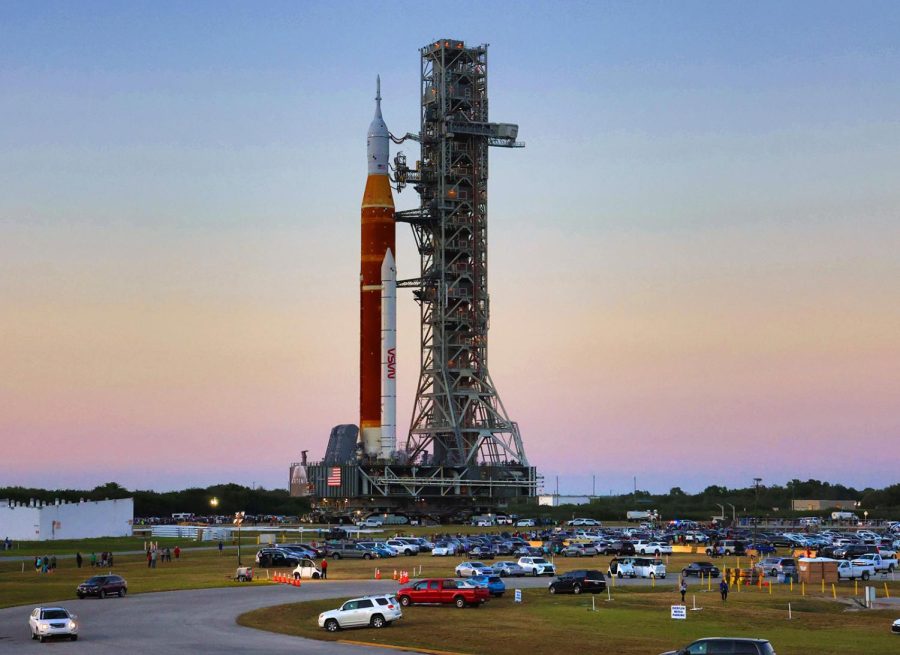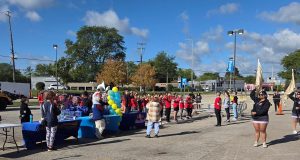How NASA plans to send humans back on the moon
Tribune News Service Joe Burbank/Orlando Sentinel
At Kennedy Space Center, Fla., NASA’s moon rocket for the Artemis 1 mission rolls to the launch pad, Thursday, March 17, 2022.
September 2, 2022
It’s official. America is going back to the moon, and this time to stay.
NASA’s Artemis 1 mission is one of a series of three missions planned to restore humanity’s presence on the moon for the first time since 1972, and to land the first woman and person of color on the moon.
The Artemis 1, an uncrewed flight, will provide valuable information to scientists and engineers in order to pave the way for future missions to the moon and beyond. Onboard the Orion capsule are various scientific instruments that will aid scientists in researching the effects of solar radiation on humans.
“Artemis stands ready,” American actress Keke Palmer said. “Ready to turn dreams into reality, ready to return humans to the moon and to take us further than ever before.”
The rocket will orbit around the moon several times while deploying ten satellites above the lunar surface to provide helpful data for future missions. This whole mission will occur over the span of 42 days with over 1.3 million miles traveled.
After completing its mission, the Orion will splash down off the coast of San Diego where NASA’s landing and recovery team will recover the capsule and transport it back to the Kennedy Space Center in Florida.
Artemis was expected to launch on Aug. 29, but due to an unprecedented engine issue the launch was scrubbed.
“While we hoped to see the launch of Artemis I today, the attempt provided valuable data as we test the most powerful rocket in history,” Vice President Harris tweeted shortly after the launch delay. “Our commitment to the Artemis Program remains firm, and we will return to the moon.”
Getting to the moon is easier said than done. Scientists will have to face many mechanical and engineering challenges to leave earth’s atmosphere and land on the moon. However, Palatine High School Astronomy teacher Sean Fisher-Rohde believes that the greater challenge may lie somewhere else.
“I think the biggest challenge that NASA will have to face is the human challenge and that is keeping people alive and mentally healthy,” Fisher-Rhode said.
He explained that coming out of lockdown two short years ago we’ve seen the effects of being cooped up with a few people in a small place, and the toll it’s taken on many people’s mental health.
“That is why,” Fisher-Rohde said. “The people who were chosen to go are going.”
During a press conference, top NASA engineers and scientists announced that the new launch date for the rocket would be on Sept. 3, 2022 anytime from 1:17 p.m. CT to 3:17 p.m. CT. If need be the launch could also be pushed back to Monday.
“We don’t launch until it’s right,” said NASA director Bill Nelson. He later said launch scrubs and delays “are just part of the space business.”
Safety is one of NASA’s most important concerns.
“I think that it would have been foolish to have had an engine bleed on one of the RS-25 engines, and still launch the rocket knowing that puts it at risk of being blown up,” Fisher-Rohde said.
The Artemis missions will mean a lot for us on earth.
“During the 1969 moon landing the world watched,” Fisher-Rohde said. The whole world was bonded together to watch two men walk on a rock 250,000 miles away. I think going back to the moon for the first time in 53 years will be something that will bring people together and that’s something that the world needs right now.”
He explained that people are fascinated, curious, and invested about what’s up there. These minds from around the world sit on the edge of their seats wondering what is next for the future of spaceflight, and ultimately the future of humanity. To watch a live stream of the Artemis launch visit NASA’s website at nasa.gov/nasalive.








